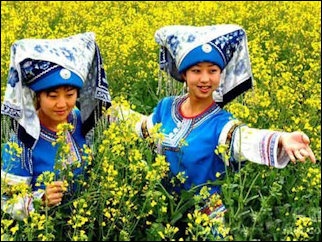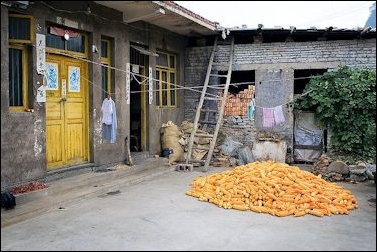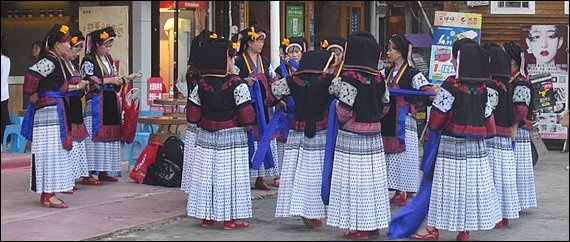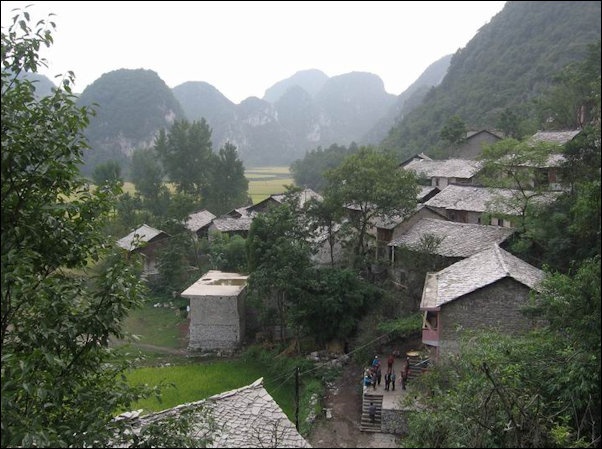BOUYEI CUSTOMS

If a boy becomes sick, or suffers some small misfortune, it is thought that it is because he has not worshipped important Bouyei mother goddesses correctly. His parents call a yaya (female shaman) to carry out the necessary appeasement ceremonies. The mother goddesses are associated with different places and things. There is a Mother Goddess of the Bed, the Mother Goddess of the Fields, the Mother Goddess of the Hills, the Mother Goddess of the Rivers—which each offering protection for children in the territory that they govern. [Source: Ethnic China *]
The Bouyei have traditionally been kind and welcoming to travelers and foreigners, offering food and drink to any person that arrives to their homes. The staple food of the Bouyei is rice. They are fond of dog meat. Bamboo is associated with strong generative power. Some times barren woman put a stick of bamboo in the head of their bed. Orphans usually are protected by a bamboo stick before their house. This cult maybe is related to a legend that explains how one of the Bouyei former kings avoided many difficulties hiding himself inside a bamboo. *\
Bouyei taboos: 1) During the baptism for the village, strangers are prohibited entering. 2) On 'the Wu day', 'Jiazi day', laboring and going out must be avoided. 3) You can't break earth from January 1 to 3, 4) You can't work and use reamer on the January 15. 5) On April eight can't let cattle plow fields. 6) No farm work can be for several days after the first time thunder of the year; 7) No one is allowed to touch and cut for the tree of the God of mountain, a big arhat tree in the village. 8) Visitors are forbidden from touching shrines. 9) Spiders beside the fire pit should not be killed. 10) Women mustn't return to their mother's home to have a baby. 11) Pregnant women are prohibited from walking through the main room of a house and are not allowed to go out for one month after giving birth to a baby. [Source: Chinatravel.com]
See Separate Articles: BOUYEI MINORITY: HISTORY, RELIGION AND FESTIVALS factsanddetails.com ; BOUYEI IN THE 1900s factsanddetails.com
RECOMMENDED BOOKS: “The Bouyei of China” Amazon.com; “Leaves and Songs as Matchmakers: The Buyis” by Ma Hexuan Amazon.com; “The Bouyei Language” by Will Snyder Amazon.com; “Bouyei-English Lexicon” by Thomas J. Hudak Amazon.com; “The Roots of Asian Weaving: The He Haiyan collection of textiles and looms from Southwest China” by Eric Boudot and Chris Buckley Amazon.com; “Writing with Thread Traditional Textiles of Southwest Chinese Minorities” by University of Hawaii Art Gallery Amazon.com; “Guizhou Batik” by Wan Zhixian and Ma Zhenggrong Amazon.com; “The Art of Silver Jewellery: From the Minorities of China, The Golden Triangle, Mongolia and Tibet” by René Van Der Star Amazon.com; “Amid the Clouds and Mist: China’s Colonization of Guizhou, 1200–1700" (Harvard East Asian Monographs) by John E. Herman Amazon.com; “Empire and Identity in Guizhou: Local Resistance to Qing Expansion” by Jodi L. Weinstein Amazon.com; “Narrating Southern Chinese Minority Nationalities: Politics, Disciplines, and Public History” by Guo Wu Amazon.com
Bouyei Marriage and Wedding Customs
Bouyei couples marry at a young age, usually around 16 and sometimes as young as 12. Young males and femsale are permitted to enjoy a "golden period of life" in which premarital sex is allowed and even encouraged. Traditionally, young women signaled their interest in a young man by tossing him a silk ball. If he was interested they dated and later became engaged to marry.

The Bouyei are monogamous, but young people of opposite sexes mix freely before marriage. When they go to fairs or other festivities, unmarried young men and women get together to sing songs. If a woman is attracted to a man, she will throw him a ball made of silk strips which she has embroidered herself. If the man is agreeable, they then make a date at which they will sing love songs to each other. After several dates, they may announce their engagement. In the old days—and to some degree today— most marriages were arranged by parents. [Source: China.org |]
A lot of single young men and ladies express their love by blowing the wood leaf or singing songs. When young man wants to get engaged his family asks a matchmaker to go to the lady's house to propose. Once they get engaged, the lady's family hosts an engagement dinner with relatives and friends. Two or three days ahead of the wedding, half a pork, a rooster and duck and a pot of water are sent from the bridegroom's to the bride's house. The bride's family also hosts a banquet at the time of the wedding. In the past, bride didn't move to her husband’s home until after one or two years' living in her mother's home. [Source: Chinatravel.com \=/]
The Bouyei have strict penalties for adultery. Traditionally, if a woman and a man had sexual relationships outside of their marriage and a child is born, that child was killed. The Bouyei believe that, after her death, the mother becomes a type of ghost known as Duyang. This ghost can cause great nuisance to people, including illness. To expel her, complicated ceremonies are performed. The Bouyei have some sexuality cults usually set up for women to get pregnant or to give birth to boys. Some times the female sex is symbolized by stone pools that never get dry, and the male sex by some stone pillars, on which a red cloth is hung as a symbol of fertility. [Source: Ethnic China]
Bouyei Houses
The Bouyei have traditionally lived on the sides of hills and along rivers in plains or river valleys in villages composed of families from several different clans, in two-storied houses, bungalows or a combination of the two. A village is made up of several dozen, or even several hundred, families. The main housing types pile dwellings, bungalows, are Diaojiaolou (the building with the hung wood feet) and wood and stone structure and stone slab buildings that are unique to Bouyei.
The Bouyei are famous for their unusual houses (stone or wooden structures with railings, stone slated roofs and stone blocks fastened with no motor or plaster). Some houses are bungalows. Some are two-story dwellings with animals living on the bottom floor. The houses of common people are mostly houses with pavilions or half storied building—with a front side like a storied building and a back like a bungalow) made of flagstones. The Bouyei areas of Zhenning and Anshun in Guizhou province abound good quality building stones— a kind of shale layers of even thickness. The walls of the Bouyei flagstone houses are made by laying stone sheets and stone blocks on top of one another, sometimes to a height reaching as high as 5 or 6 meters. The roof is constructed by placing stone sheets together to form diamond or scale-like shapes according to the shape and quality of the stone. The houses made of stone not only resist heavy wind and rain, they are attractive and elegant in their simplicity. Except for the rafters, which are made from sandal wood, all the rest is made of stone. Even the furniture and daily necessities— such as tables, stools, the hearth, bowls, pestles, grinds, cisterns, jars and basins—are all chiseled out of stone. All are simple but heavy. The Bouyei stone house is warm in winter and cool in summer, and can resist fire and moisture. Its main weakness is that it gets relatively little daylight and is dark inside.[Source: Liu Jun, Museum of Nationalities, Central University for Nationalities ~]
There are dozens of three or four storied stone buildings Chengguan Town in Zhenning Bouyei and Miao autonomous county. The color of the stone material is light gray, which makes the houses appear brilliant during the day and silvery under the moonlight. This is why the town has been known as "silver Zhenning" since old times. Some of the old weathered stone buildings are said to be more than 600 years old. ~
The process of building houses is quite meticulous and . First, a professional designer-feng shui selects a place using "fengshui". The ideal place should be beside a mountain and a river. The back of the house should be oriented towards green mountains and face towards verdure hills. The mountains at the back ideally should be shaped like "lying lions guarding around", "dragons surrounding in defensive formation" or "a noble man riding on horse back", while the mountains at the front should be shaped like "two dragons fighting for jewelry", "double dragons playing with a pearl", "thousands of horses returning to stables" or "the god of longevity rising up". Fortunately, the area where the Bouyei people live abounds with karst hills and limestone rock formations so it is not difficult to find such kind of place. ~
A fortuneteller, shaman or feng shui master is consulted to determine an auspicious day for starting the construction. One month before this day, a carpenter is invited to prepare the frame of the house made with completely new materials. When the structure is erected on the auspicious day, Master Lu Ban (father of the carpenter) is honored by a sacrifice. The beam is delivered from the father of the wife and it is decorated with big flowers made by red silk. The deliverance is accompanied by an orchestra and a team of acrobatic performers. When the beam is fixed, a singing and dancing ceremony and the feast is held. Finally, the memorial tablet of ancestors and the god of cookery is positioned honorably in new house. ~
Bouyei Food and Drink
Glutinous rice is the staple food. Bouyei like to eat steamed rice cooked with a special 'zengzi' cooker. Cold dishes, lichen frozen meat, and peas mixed with rice noodle are favorite dishes. Sour dishes and sour soup are served at almost every meal, and are especially popular with women. The Bouyei also eat blood tofu, sausage, dishes made with bamboo shoot and various insects. Among the many traditional snacks are pastries, cakes and sweets made with rice powder, pea powder, honey and sugar. [Source: Chinatravel.com \=/]
Wine is important role in daily lives of Bouyei people. After the autumn harvest, families make plenty of rice wine and store enough to last the year. Bouyei people like to entertain guests with the wine and guests are expected to drink a lot. When guests arrive, wine named as 'wine for welcoming guests' is served. Drinking is done with bowls rather than cup or glasses, often accompanied by finger-guessing drinking games and singing. \=/
Bouyei Clothes and Wax-Dying
The Bouyei are famous for their blue homespun cloth and batik (wax-dyed cloth). Men and women wear a long sarongs or skirts. Women dress in dark clothes with a colorful trim and wear special headgear if they are married. Amongst the 56 ethnic groups of China, the Miao and Bouyei are well-known for batik. According to the Shanghai Museum: Bouyei women's wear features simple and fresh batik decoration. Geometric shaped spiral pattern is the main design of batik patterns, with a saw tooth pattern added, and they form patterns symbolizing the sun and light. Bouyei batik is well structured and delicate in design with a proper combination of lightness and abundance, and with rich layers. This sort of garment is also known as the ‘railing dress’, referring to the lace edging.
Bouyei dress is varied and influenced by many factors: 1) The four main regional dressing patterns correspond with the regions where their four main dialects are spoken; 2) Religious beliefs and totems are reflected with water designs and images of mountains, fish and dragons embroidered in their clothes. Mountains and other nature powers are usually present in their clothes. 3) The clothes worn by women especially are often related with their age and marital status, with different steps in the life of a woman—particularly marriage—clearly depicted in their dresses. 4) Dress is often related to local customs and the occasion, with one set of clothes for everyday wear and one set for festivals and celebrations. At big festivals or wedding parties, the women like to wear their best clothes, that among other things show off their embroidering skills. [Source: Ethnic China *]

The wax-dyeing craft of the Bouyei has been famous for a long time. Song dynasty records indicate that wax-dyeing cloth was produced in Huishui, Guizhou province—a Bouyei region. A historical book in the Qing dynasty describes the "cyanine glower cloth", another term for wax-dyed cloth. Beginning around the ages of 12 or 13 years old, Bouyei girls learn the wax-dyeing craft from their mothers. First, wax is heated into liquid. Then bronze triangle-shaped wax knives are dipped into the liquid wax and used to carefully paint all kinds of beautiful and vivid pictures on white self-made cloth. After that the cloth is immersed in at vat of blue dye. Finally, the dyed cloth is thrown in cauldron of boiling water and the wax is boiled off and the cloth is washed several times in a river and finished when it dries. [Source: Liu Jun, Museum of Nationalities, Central University for Nationalities ~]
Finished wax-dyed cloth has rich and simple patterns, often featuring patterns of veins (also called little waves) that can not be produced by machines and have ties to the ancient Bouyei water cult. The style of wax-dyeing and the images produced vary from place to place: some places favor bold designs and vivid images and patterns of flowers, birds, insects and fishes; some feature carefully thought-out structure and fine details; others get inspiration from dragon-claw flowers with bold and bright colors. In recent decades, several dyeing factories have been established with specialized art designers creating and drafting new pictures. Various kinds of people and animal images have appeared and colors are used in a more diversified manner.
The wax-dyed cloth is mostly used for making women's shawl, gowns, aprons and bed covers and curtains. Some with high artistic features and intricate patterns are used as art hangings. Some Bouyei women knit embroidery on the wax-dyed gowns. In addition to wax-dying, the Bouyei people are also skilled at tie-dyeing, brocade, embroidery, woodcarving, sculpture and bamboo-weaving e.
Bouyei Culture
The Bouyei possess a rich folk literature, which includes fairy tales, fables, folk songs, proverbs and poems. During weddings, scores of young men and women are invited to join in antiphonal singing of a rich ethnic quality. In the Biandan Mountain area of Zhenning County, old women are invited to sing songs of blessing by firesides. They can sing day and night for up to a week without repeating the words of their ballads. Popular musical instruments of the Bouyei include the suona horn, yueqin, suona, lute, bamboo flageolet, wood leaf, vertical bamboo flutes such as the dongxiao, short xiao and sister xiao and copper drums.[Source: China.org |]
The Bouyei are skilled in arts and crafts. Their colorful and beautifully-patterned batik dates far back to ancient times. In 1953, a batik factory was built in the city of Anshun with the help of the local authorities, and traditional technology was improved. Now, batik has become one of their best-selling handicrafts, popular both on domestic and foreign markets. In addition, their colorful embroidery, exquisite summer sleeping mats and bamboo hats are not only durable and attractive, but also highly artistic. |

Bouyei village
Traditional dances include Tymbal Dance, Weaving Dance, Lion Dance and Candy Bag Dance. The traditional musical instruments contain. Di drama, flower lamp drama are the favorite dramas of Bouyei people. In recent years, specialized business enterprises for producing the Bouyei baldachin, dyed cloth with wax and national craft clothing have been set up and products are sold as far to many foreign places, such as Southeast Asia, Japan, Europe and America. [Source: Chinatravel.com \=/]
Bouyei Literature and Love Songs
The Bouyei have traditionally had no written language. Their literature—myths, legends, songs and folktales, and their sacred Mojing scriptures—has been orally transmitted:. Among their myths, "Twelve suns", "Brother and sister create the human beings" perhaps are the best known. There are many Bouyei songs that depict their customs, such as "Legends of March Third", "The Origin of Build Houses", "Killing Tigers and Shooting Eagles", "Fight with the Rhinoceros for the Pearl", and "Legends of Huangguoshu Waterfalls." "Ali" and "Asan Digs for Sow" are two Bouyei poems that describe their their fights against oppression. Their batik textiles are very famous in China, are also appreciated internationally [Source: Ethnic China *].
The Bouyei have a rich repertory of songs that are usually sung at ceremonies and festivals. In some places professional singers are hired to entertain at their weddings. Some of their songs are called “mountain songs.” Their “big songs” are sung at wedding and funerals. Their small songs are usually sung at festivals and love encounters. It is said that the Bouyei can spend six or seven days singing without repeating any song. Drums are their main musical instrument. The Bouyei regard their oldest drums as sacred. Usually there are a lot of drawings in the drum outer side. Among their dances the most famous are: Dance of Embroidery, Lion Dance and Dance of Husking Rice. *\
While young men and women are playing games and courting during their free time, they usually pick a piece of smooth leaf, and place it half rolling between their lips. With the rolled leaf in their mouth they sing harmonious and pleasant melodies to express their feelings. Some youths also use the "unrefined telephone" when singing love songs. A male and a female each hold section of bamboo connected by a string. One end of the bamboo is covered with a piece of sounding membrane (made of snake skin or thick paper). The two sections are connected by a string, which can be as long as a hundred meters. When one person sings into the bamboo piece, the other can hear clearly at the other end and others cannot hear it. In this way, couples that are courting can communicate and talk privately without the embarrassment of staring each other face to face. [Source: Liu Jun, Museum of Nationalities, Central University for Nationalities ~]
The love songs are usually plain and simple. If the singer does not have true feelings, he or she cannot perform well even with strenuous preparation. One song recorded in the General Records of Chinese Culture goes:
Male: Missing my girl too much to sleep,
River formed by tears of the weep,
Hands dragged by ghosts when doing chores,
Feet pulled by spirits when walking asides.
Female: Missing my lover and becoming impatient,
Tears dropping while grinding the wheat,
Mother asking why I am sobbing,
Saying that chaff into the eyes flying.
Bouyei Opera with Nuo Drama
Operas performed by the Bouyei include Bouyei Opera, Ground Opera and Stool Opera. With a history of more than 200 years, Bouyei Opera is the generic term for Bouyei native opera and Bouyei opera-style singing. It originated from eight-tone sitting singing (also called Stool Opera) and took its shape in the reign of Qianlong Emperor (1736-1795) during the Qing Dynasty. Today, the Bouyei Opera and the Ground Opera are often performed in vacant areas and on hillsides. around are crowded with audience, which fully demonstrates their popularity. [Source: Liu Jun, Museum of Nationalities, Central University for Nationalities ~]
The Bouyei Opera is performed by amateur folk craftsmen who divide themselves into groups. Each group has about 30 people, and the actors are divided into main actors, main actresses, minor roles, kings and warriors and so on. The accompanying instruments include the pans, drums, the urheen, the yu-kin (a stringed instrument), bamboo flute and wooden fish. Bouyei language is used in the songs, monologue, dialogue and satire, but the Chinese language is used in the prologue, final poem and self-introductions. The plays can be classified into traditional stories, legends and Han Chinese stories. These plays are usually staged during the Spring Festivals or times when there is little agricultural work to do. Before the opera, there is a “Jumping as Promoting” ceremony to honor the God of Opera, and after that sweeping the stage is necessary. These are all set rules such as "Civil officials swing the fan while warriors carry sword".
The Ground Opera gets its name for the fact that it is performed on the ground and there is no stage and backdrop. Tradition has it that the Ground Opera was learned from other nearby ethnic groups. The performing groups are all composed of amateur farmers who usually belong to the same village. They organize in groups and perform in villages one after another during the slack agricultural season. When performing, the actors dress in costumes, wear masks on their foreheads and black gauze over their faces. The warriors wear chicken feathers on the heads and small flags on the backs. The masks are carved out of aspen wood. Various kinds of people's face are painted on the masks. Some have beards and are extremely vivid. The plays are accompanied by orchestral music and percussions, and the stories are mainly adapted from historical fictions such as “Talking about the Tang Dynasty,” “Biography of Yue Fei,” and “Warriors in the Yang Family.” The Opera is sung in the Bouyei language. Some experts believe that Ground Opera originated from Nuo in old times and it is the "living fossil" of opera art.
Image Sources: Wikimedia Commons, Nolls China website
Text Sources: 1) “Encyclopedia of World Cultures: Russia and Eurasia/ China”, edited by Paul Friedrich and Norma Diamond (C.K. Hall & Company; 2) Liu Jun, Museum of Nationalities, Central University for Nationalities, Science of China, China virtual museums, Computer Network Information Center of Chinese Academy of Sciences, kepu.net.cn ~; 3) Ethnic China *\; 4) Chinatravel.com ; 5) China.org, the Chinese government news site china.org | New York Times, Lonely Planet Guides, Library of Congress, Chinese government, National Geographic, Smithsonian magazine, Wikipedia, BBC and various books, websites and other publications.
Last updated October 2022
